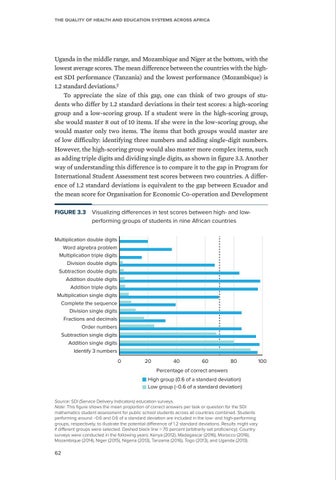The Quality of Health and Education Systems Across Africa
Uganda in the middle range, and Mozambique and Niger at the bottom, with the lowest average scores. The mean difference between the countries with the highest SDI performance (Tanzania) and the lowest performance (Mozambique) is 1.2 standard deviations.9 To appreciate the size of this gap, one can think of two groups of students who differ by 1.2 standard deviations in their test scores: a high-scoring group and a low-scoring group. If a student were in the high-scoring group, she would master 8 out of 10 items. If she were in the low-scoring group, she would master only two items. The items that both groups would master are of low difficulty: identifying three numbers and adding single-digit numbers. However, the high-scoring group would also master more complex items, such as adding triple digits and dividing single digits, as shown in figure 3.3. Another way of understanding this difference is to compare it to the gap in Program for International Student Assessment test scores between two countries. A difference of 1.2 standard deviations is equivalent to the gap between Ecuador and the mean score for Organisation for Economic Co-operation and Development FIGURE 3.3 Visualizing differences in test scores between high- and lowperforming groups of students in nine African countries Multiplication double digits Word algrebra problem Multiplication triple digits Division double digits Subtraction double digits Addition double digits Addition triple digits Multiplication single digits Complete the sequence Division single digits Fractions and decimals Order numbers Subtraction single digits Addition single digits Identify 3 numbers 0
20
40
60
80
Percentage of correct answers High group (0.6 of a standard deviation) Low group (−0.6 of a standard deviation) Source: SDI (Service Delivery Indicators) education surveys. Note: This figure shows the mean proportion of correct answers per task or question for the SDI mathematics student assessment for public school students across all countries combined. Students performing around −0.6 and 0.6 of a standard deviation are included in the low- and high-performing groups, respectively, to illustrate the potential difference of 1.2 standard deviations. Results might vary if different groups were selected. Dashed black line = 70 percent (arbitrarily set proficiency). Country surveys were conducted in the following years: Kenya (2012), Madagascar (2016), Morocco (2016), Mozambique (2014), Niger (2015), Nigeria (2013), Tanzania (2016), Togo (2013), and Uganda (2013).
62
100


